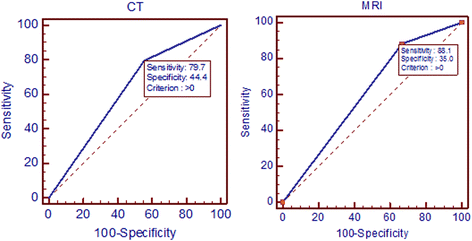Diagnostic accuracy of contrast-enhanced computed tomography and contrast-enhanced magnetic resonance imaging of small renal masses in real practice: sensitivity and specificity according to subjective radiologic interpretation
- PMID: 27729042
- PMCID: PMC5059933
- DOI: 10.1186/s12957-016-1017-z
Diagnostic accuracy of contrast-enhanced computed tomography and contrast-enhanced magnetic resonance imaging of small renal masses in real practice: sensitivity and specificity according to subjective radiologic interpretation
Abstract
Background: The aim of this study was to investigate the diagnostic accuracy of contrast-enhanced computed tomography (CT) and contrast-enhanced magnetic resonance imaging (MRI) of small renal masses in real practice.
Methods: Contrast-enhanced CT and MRI were performed between February 2008 and February 2013 on 68 patients who had suspected small (≤4 cm) renal cell carcinoma (RCC) based on ultrasonographic measurements. CT and MRI radiographs were reviewed, and the findings of small renal masses were re-categorized into five dichotomized scales by the same two radiologists who had interpreted the original images. Receiver operating characteristics curve analysis was performed, and sensitivity and specificity were determined.
Results: Among the 68 patients, 60 (88.2 %) had RCC and eight had benign disease. The diagnostic accuracy rates of contrast-enhanced CT and MRI were 79.41 and 88.23 %, respectively. Diagnostic accuracy was greater when using contrast-enhanced MRI because too many masses (67.6 %) were characterized as "4 (probably solid cancer) or 5 (definitely solid cancer)." The sensitivity of contrast-enhanced CT and MRI for predicting RCC were 79.7 and 88.1 %, respectively. The specificities of contrast-enhanced CT and MRI for predicting RCC were 44.4 and 33.3 %, respectively. Fourteen diagnoses (20.5 %) were missed or inconsistent compared with the final pathological diagnoses. One appropriate nephroureterectomy and five unnecessary percutaneous biopsies were performed for RCC. Seven unnecessary partial nephrectomies were performed for benign disease.
Conclusions: Although contrast-enhanced CT and MRI showed high sensitivity for detecting small renal masses, specificity remained low.
Keywords: Computed tomography; Magnetic resonance imaging; Renal cell carcinoma.
Figures
References
Publication types
MeSH terms
Substances
LinkOut - more resources
Full Text Sources
Other Literature Sources
Medical


